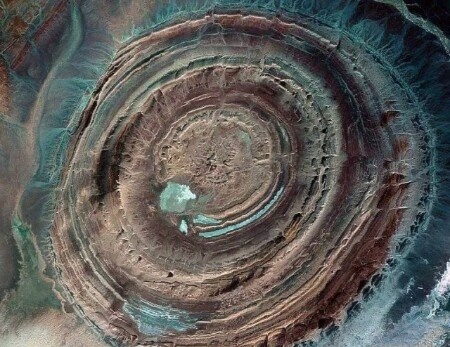SAEDNEWS: The Eye of the Desert (Sahara) is one of the world’s most unique natural wonders. Explore this mysterious desert and uncover its secrets.

According to the Tourism Service of SaedNews, the Eye of the Sahara, also known as the Richat Structure, is a geological formation located in the desert near Ouadane, Mauritania. This unique and striking feature is a massive circular structure with a diameter of approximately 30 miles (50 kilometers). Its concentric rings and symmetrical pattern, when viewed from above, give it the appearance of a giant bull’s eye—hence the name "Eye of the Sahara."

The Eye of the Sahara is situated on the Adrar Plateau, a rocky region in Mauritania in northwestern Africa. Its coordinates are approximately 21°07′N latitude and 11°22′W longitude. The area is characterized by arid desert conditions, which make the Eye of the Sahara stand in stark contrast to the surrounding landscape. Despite its impressive size, the structure is not easily visible from the ground due to the relatively flat and featureless topography.
At first glance, the Richat Structure’s concentric rings and circular ridges resemble a giant bull. This distinctive circular shape inspired various early theories about its formation, including speculation that it could be the location of the lost city of Atlantis.

While some experts initially thought the Eye of the Sahara was a massive impact crater, later studies revealed a more complex geological origin involving Earth’s internal processes.
Thanks to modern geological research, including satellite imagery provided by organizations like NASA’s Earth Observatory, scientists now understand that it is a prominent geological dome composed of layers of sedimentary rock that have been exposed over millions of years to wind and water erosion.
The concentric rings of this formation are primarily made up of sedimentary rocks, including sandstone and limestone. The outermost ring consists of harder, more resistant rock layers, while the innermost depressions are made of softer rock layers that have eroded more quickly over time.
These sedimentary layers offer a window into Earth’s past, recording millions of years of geological history. Just as imagining moisture in the Sahara Desert seems improbable, the circular ridges of the Richat Structure have helped scientists study past wet and dry periods in the region’s history.
The Eye of the Sahara also contains an alkaline igneous complex, including gabbroic rocks formed through magmatic activity and hydrothermal metamorphism. In simpler terms, parts of the Earth’s crust were heated to molten rock, which then intruded into surrounding rock and slowly crystallized into solid formations.
Erosion, both by wind and water, has sculpted the Richat Structure into its current form, exposing various rock types and creating its concentric rings and circular appearance. The differing erosion rates between softer and harder layers have contributed significantly to the striking appearance of the formation today.

One of the most fascinating aspects of the Richat Structure is its resemblance to a massive eye when viewed from space. This unique feature has captured the attention of scientists and astronauts alike. Images of the Eye of the Sahara were captured during the Gemini IV mission, and astronauts aboard the International Space Station have also photographed it.
The geological importance of the Richat Structure extends beyond its visual appeal. It provides valuable insights into Earth’s geological processes, including tectonic forces, erosion, and magmatic activity. Additionally, its sedimentary layers preserve evidence of past environments and potentially even early human activity.
Some researchers speculate that the Richat Structure may have been inhabited by early humans, such as Homo erectus or Homo heidelbergensis. Evidence of stone tools, including Acheulean hand axes, has been found in the surrounding landscape, suggesting that early humans may have used the Eye of the Sahara for hunting or temporary shelter.
Due to its remote location and the challenging desert environment, the Eye of the Sahara is relatively difficult to access. Nevertheless, there is significant interest in this geological wonder, and efforts have been made to facilitate access for researchers, scientists, and adventurous tourists. It should be noted that conditions and accessibility may have changed since this report was written.

